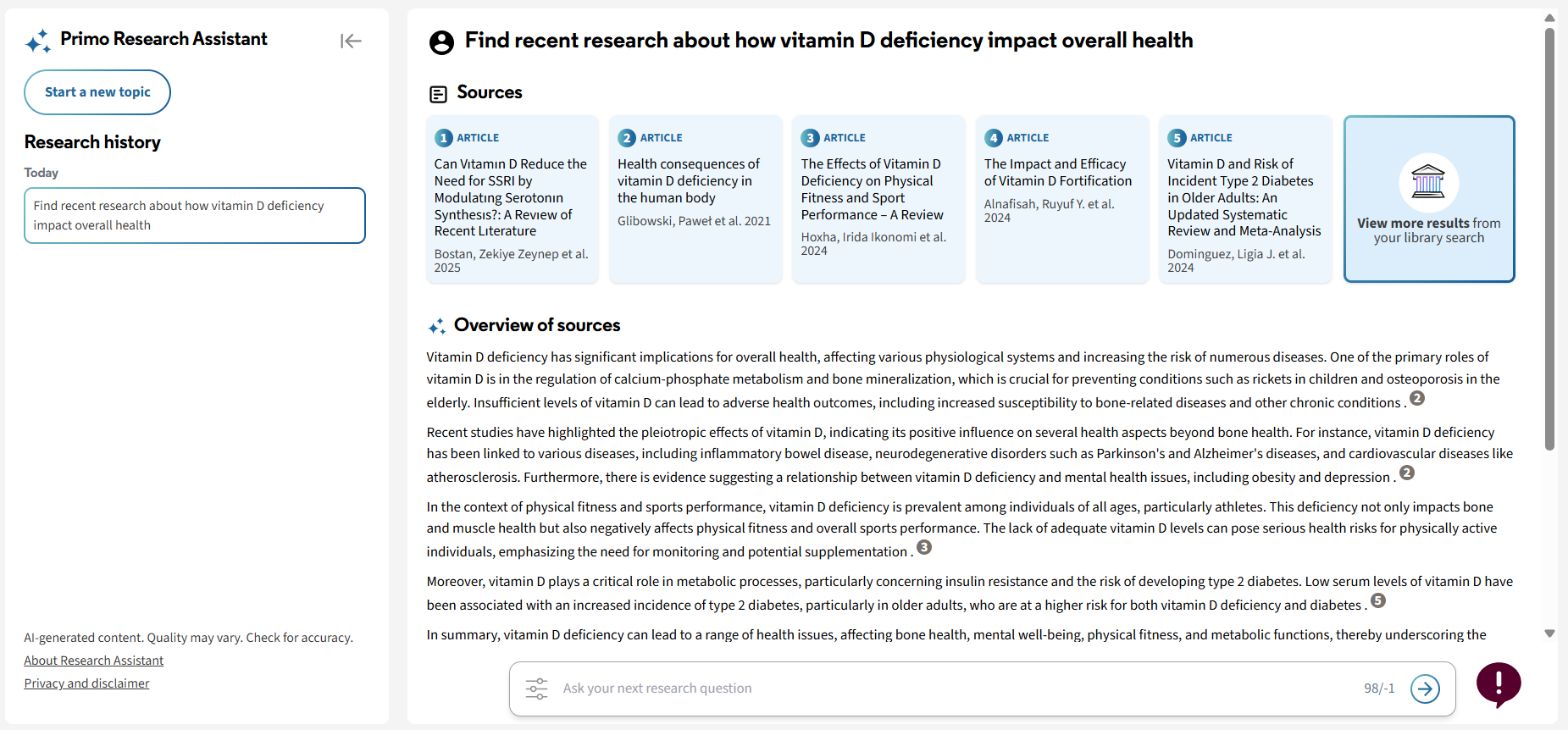Basic interface elements
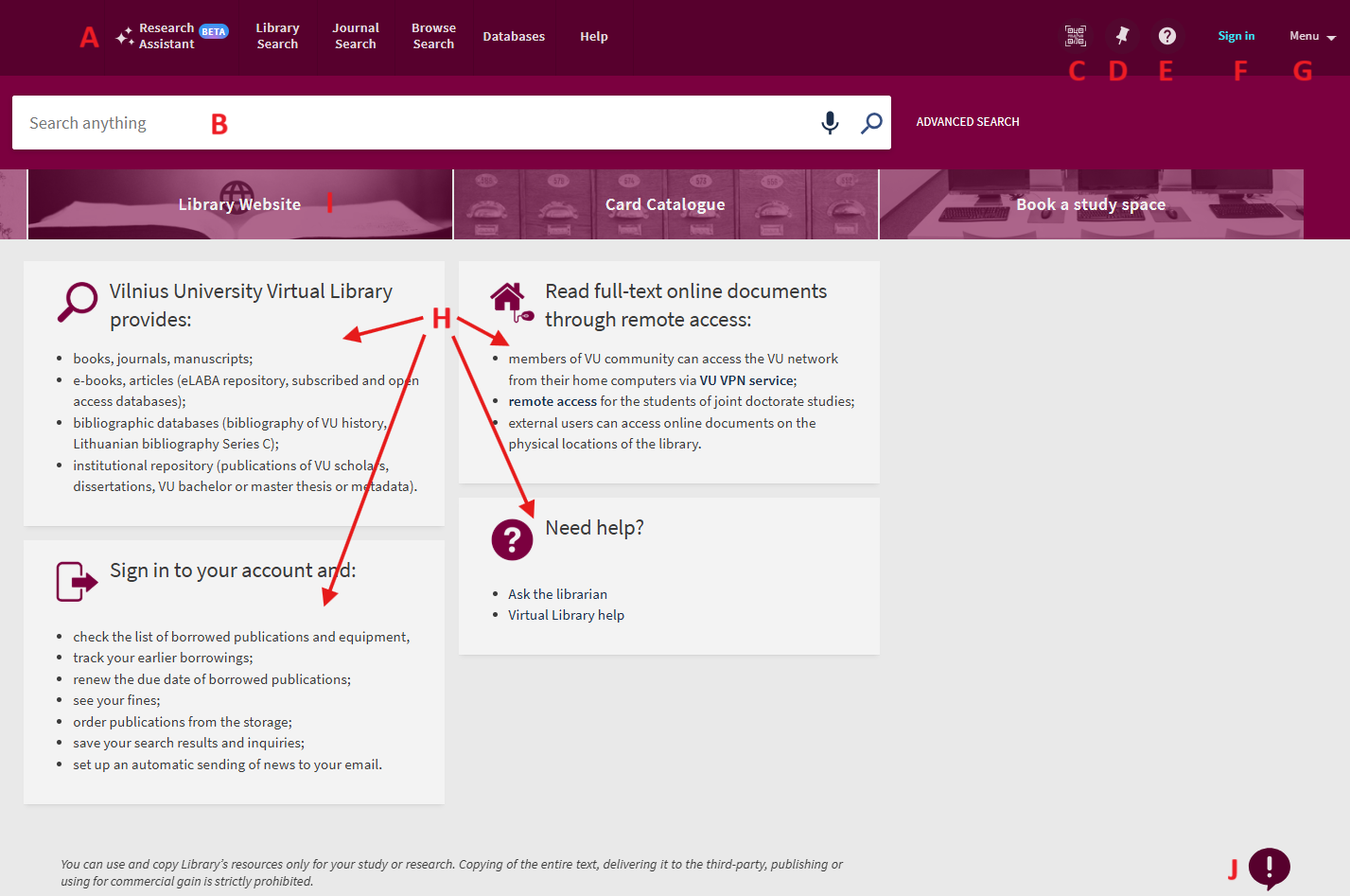
The new user interface has the following key elements:
- The main menu.
- The search bar.
- The link to QR code.
- The link to Favorites.
- The link to Search Tips.
- The Sign In link.
- The link to additional user services.
- Static information fields.
- Links to other library services.
- The Give us feedback link.
How to Change the Language of User interface?
To change the user interface language:
1. Open user's main menu or click on your name displayed.

2. Select „Display Language: English“ from the pop-up menu that opens:
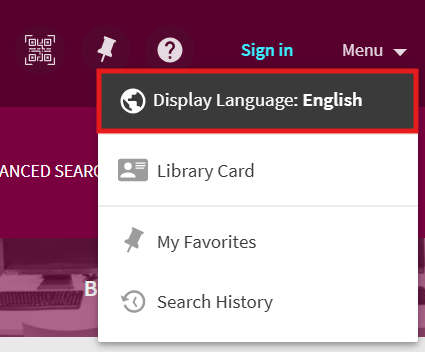
3. Choose the required language from the pop-up menu.
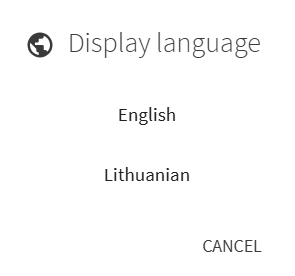
Basic Search
You can search very easily in Primo:
- Type one or more search words. To enter an incomplete word, see "Using Wildcard Characters in Search" section.
- Click the "Search" button (a magnifying glass image on the right from search words).
- If you enter multiple words, Primo will return results that contain all of the specified terms. When searching by entering ISBN and ISSN, values are searched with or without hyphens. If you are not getting expected results with hyphens, please try your search again without hyphens.
Searching for an Exact Phrase
To search for an exact phrase (words next to each other and in exact order), type quotation marks around the phrase. For example, to search for "service management" as one term, type the following in the search box:

You can combine both words and phrases in your search. For example "service management" marketing will perform a combined search:

Using Logical Operators in Search
Searching for Any Specified Words
If you want to find resources that contain at least one search word entered in the search box, you must use the Boolean (logical) operator OR. Logical operators should be written in all capital letters - otherwise Primo treats it as a simple word search.
For example, to search for items with the word Lithuanian or the word English, type the following in the search box:
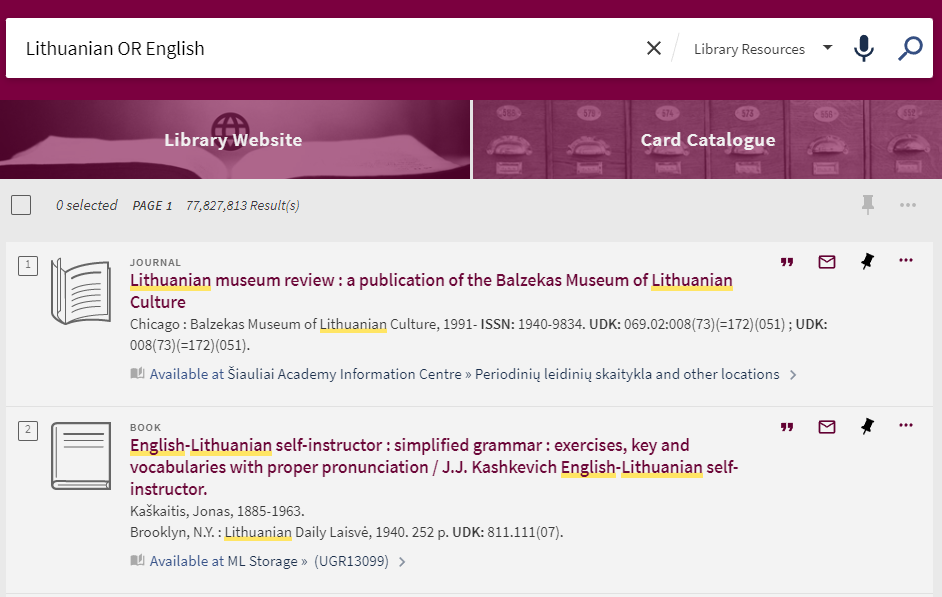
Refining Search Results by Excluding Words or Phrases
Search results may be refined by typing in the search box condition NOT and then type the word to exclude.
For example, to search for items with the word Lithuanian but not the word English, type the following in the search box:
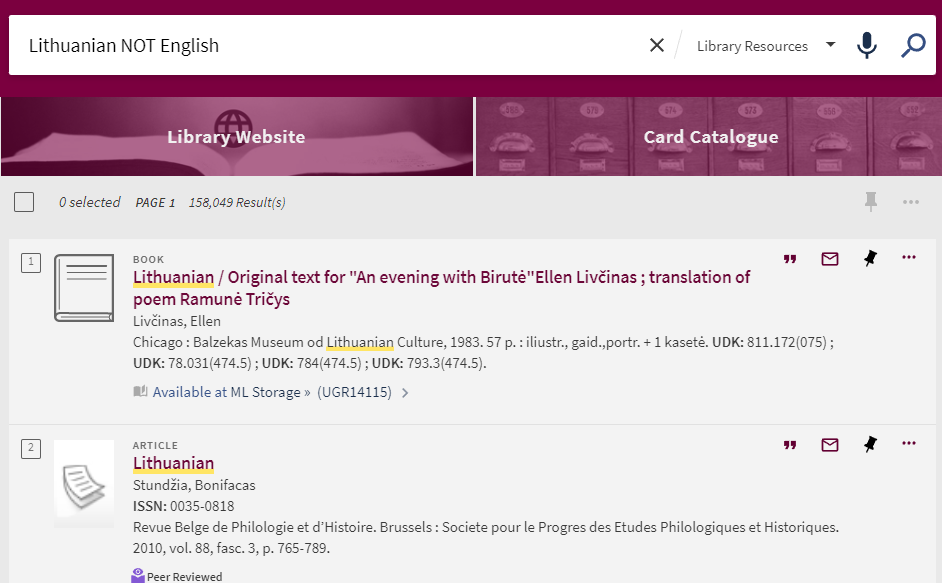
You can combine OR, AND, NOT logical search operators. Such searches can be grouped with parentheses. If the parentheses are not used, the NOT operator must be used last. For example: Lithuanian AND English NOT Russian. If it is necessary to place the NOT operator elsewhere, make sure that you enclose the operation with parentheses. For example: (Lithuanian NOT Russian) AND English.
Grouping Search Terms
You can use parentheses to group terms to clarify the order when searching for more than one type of logical operator.
For example, when searching for records that contain Shakespeare and either tragedy or sonnet the search query should be written as Shakespeare AND (tragedy OR sonnet). If no parentheses are specified in the above query, Primo will instead group the words as follows: (Shakespeare AND tragedy) OR sonnet and will search for Shakespeare tragedies and any sonnet.
Using Wildcard Characters in Search
In the middle or at the end of search words Wildcard characters ? and * can be used. The Wildcard character entered at the beginning of the search word will be ignored.
? – enter a question mark to perform a single character wildcard search. For example, type wom?n to search for records that contain the strings woman, women, and so forth.
* – enter an asterisk to perform a multiple character wildcard search. For example, type cultur* to search for records that contain strings, such as culture, cultural and culturally.
Searching in the Selected Search Scope
The search scope defines where the system should perform the search. The default search scope is called “Library Resources” and consists of all local catalogues, subscribed and freely available resources from Vilnius university library. The search scope can be changed by selecting a search scope from the drop-down list in the search box:

Tips for selecting a search scope:
- When searching for physical documents – books, newspapers, manuscripts, graphics cabinet works, rare prints, maps - it is recommended to choose the resource "Physical resources". Then there will be fewer results, no e-documents and it will be easier to find the book or other publication you want to order.
- To search only for electronic resources – e-books, articles, magazines, encyclopaedias, manuals, dictionaries – it is recommended to choose the resource “Electronic resources”.
- If you are looking for bibliographic data on publications in the press and on Internet portals dedicated to the history or current activities of Vilnius University and Šiauliai University (up to year 2020) in various languages, it is recommended to choose the resources of “Bibliographic database”.
- If you are looking for publications, final theses, doctoral dissertations and their summaries published by Vilnius University and Šiauliai University (up to year 2020) lecturers, researchers and students – it is recommended to choose the resource “Institutional Repository”.
Searching in the Remote Resources
The subscribed and Open Access resources include the Central Discovery Index and EBSCOhost index records managed and distributed by Ex Libris. By default, only the results with full text access are provided from both of these two indexes. If you want to receive results from Central Discovery Index of items that do not contain full text, select the “Expand My Results” in “Tweak your results” section.
Attention: there is no such option for EBSCOhost items.
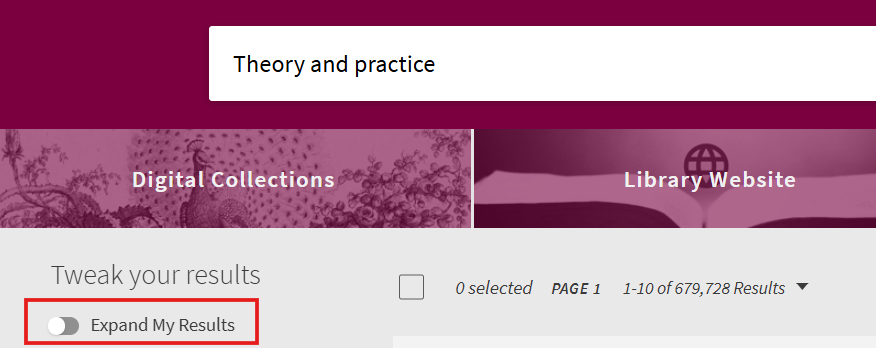
Search Limitations
The system will display a message and provide suggestions when the following limits are exceeded:
- The query contains more than 30 logical operators.
- The query contains more than 8 question marks.
- The query contains more than 8 asterisks and the word length is greater than 2 (such as abb* or ab*c).
- The query contains more than 4 asterisks and the word length is less than 3 (such as ab*).
- The entire query consists of a single letter and an asterisk (such as a*).
Advanced Search
The Advanced Search allows you to specify additional lines of criteria, specify filters prior to executing the query, combine queries with logical operators.
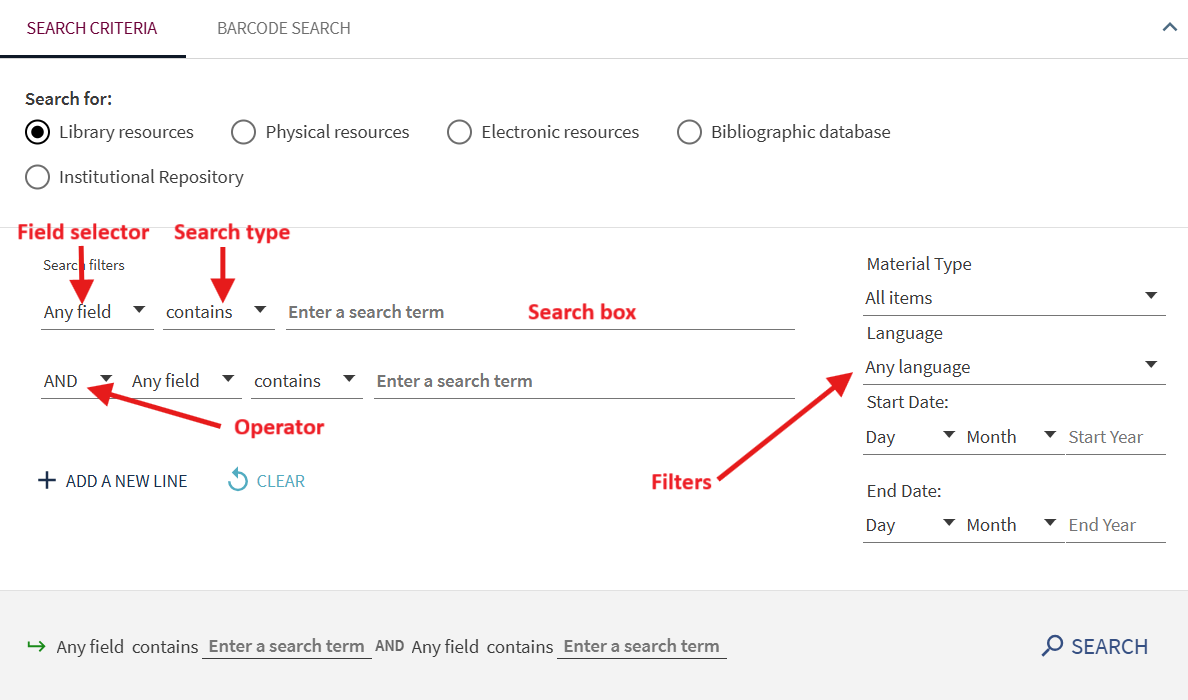
The Advanced Search page contains the following components and options:
- Field selector – For each search line, this parameter allows you to narrow the search to all search fields or a particular field (such as title and subject).
- Search type – For each search line, this parameter indicates whether the phrases in your query are treated as phrases or exact phrases. The following values are valid: is (exact), contains, starts with.
- Operators – As with basic searches, you can include the following operators between words and phrases in each search line: AND, OR, and NOT. See "Using Logical Operators in Search" for more information.
Barcode Search
If you are looking for a specific copy of a publication, select Barcode Search in the advanced search. By entering the barcode in the search field and clicking "Search", the system will find the copy of the publication you are looking for.

Voice Search Assistant
This enhancement allows users to enter search terms using their device's microphone.
After selecting the Microphone icon, users can begin speaking search terms or select a different language for the system to detect.
If no input is detected for 10 seconds, the system will provide a message and then prompt the user to provide audio input two more times before timing out and exiting the voice search assistant.
If audio is detected, Primo will display the relevant search results.

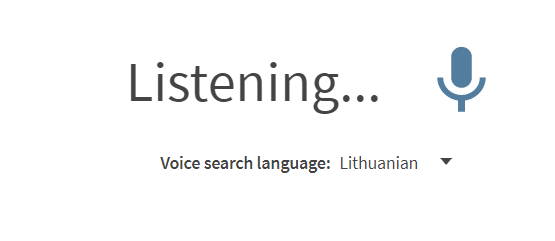
Note! This feature is available for all browsers that support the Speech Recognition interface of the Web Speech API (such as Chrome for Desktop and Android browsers and Samsung browsers). It will be progressively available in other browsers as they support the Web Speech API.
Using Browse Search
In order to use The Browse search, click “Browse Search” in the main menu. This search allows you to browse library local materials by author, title, subject and call numbers. To see related records, just click on results.
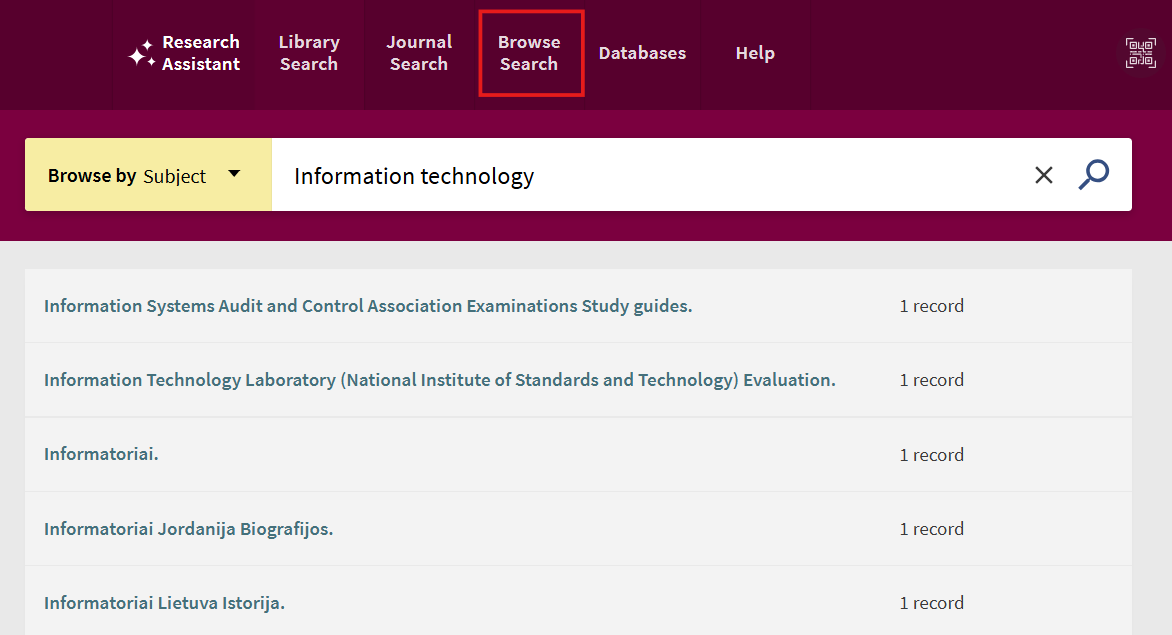
User Space
Why Everyone Should Sign In?
When you sign into Virtual Library, you are able to do the following:
- You can set your preferences so that they reflect the way you usually search, and save them for future sessions.
- You can save items and queries for future use.
- The institution offers licensed information resources to its users. Once you sign in, you can search and retrieve items from these additional resources.
- Use library services such as requesting or recalling items.
How to Sign In?
- To Sign in, click the “Sign in” option at the top of any page.
 In the login screen, select the appropriate login method: if you are a VU student or employee, select "VU community member"; if you are an external user and have a personalized user card, select "External user". Enter your user name and password.
In the login screen, select the appropriate login method: if you are a VU student or employee, select "VU community member"; if you are an external user and have a personalized user card, select "External user". Enter your user name and password.

If the login fails, we recommend changing the password.
Please note:
-
The system may not recognize the characters you selected if you use Lithuanian letters (ą, č, ę, ė, į, š, ų, ū, ž) in the password.
-
The password must consist of Latin (English) letters, numbers and special characters.
-
The password should consist of less than 20 characters.
Members of the VU academic community can change their password by logging in to id.vu.lt. Other readers with library cards should contact the Information Desk staff for a password reset.
Why Everyone Should Log Out?
To keep your personal data safe, do not forget to log out:
- To Log out, click the Sign-In area at the top with your name displayed.
- Click “Sign out” button.
- It’s recommended to close the browser window.
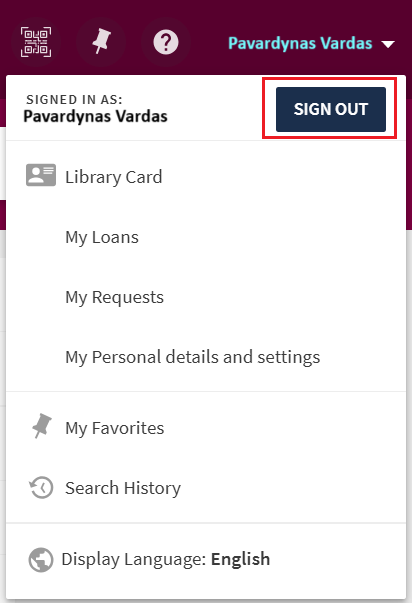
My Account
With the “My Library Card” feature, you can:
- Extend the deadlines for loan items
- Read messages the library staff posted you
- Change your personal settings.
“My Library Card” is accessible by clicking the Sign-In area in the upper right corner of the screen and choosing “Library Card” in the expanded menu.
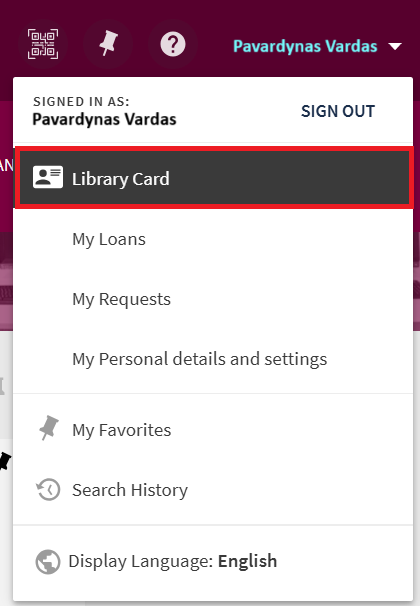
Logged in users in “My Library Card” will find:
- Loans – active and historical loans.
- Requests – on hold requests.
- Fine + fees – penalties and fees for non-returns.
- Blocks + messages – all general messages and any blocks that may prevent you from accessing services in the library.
- Personal details – user data validity, option to change default interface language, etc.

QR code
Use a QR code for better sharing of your search outcomes with others. After performing the search in the virtual library and applying the necessary filters, you may share your search outcomes with other users:
1. Click the QR Code icon at the top of the page.

2. Save the QR Code or copy a link to your search outcomes page by selecting “Copy Link”.
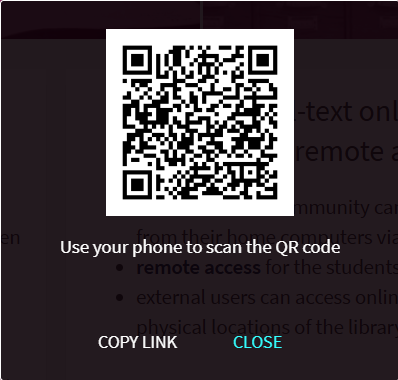
3. By scanning the QR Code with your mobile device or by opening the copied link you’ll get the same search outcomes with the previously applied filters.
If you want to share some specific records with other users, open a detailed bibliographic record and in a section “Send to” select an QR Code icon.

A QR code might be useful in the following situations:
- Lecturers can make a list of search outcomes for a specific course and include the QR code of the list in the presentation.
- After receiving queries from users, librarians can perform the search and instantly share the received outcomes by letting users scan QR codes with their mobile phones.
Using My Favorites
The My Favorites page, which is accessed by clicking the My Favorites button (Pin) at the top of each page, contains the following:
- Saved Records – displays all of your saved records and allows you to manage your saved records.
- Saved Searches – displays all of your saved searches and allows you to manage your saved searches. Lets you set up alerts and RSS feeds, which let you know when results have changed for saved searches.
- Search History – displays all of your searches for the current session and allows you to manage your current session's searches.
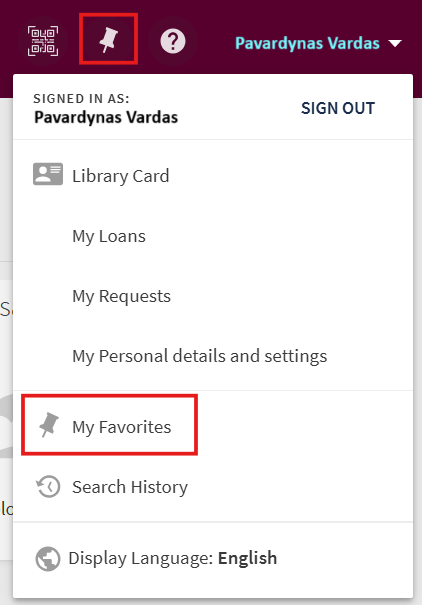
Saving and Managing Records
Signed-in users are able to save found records for subsequent sessions. After a record has been saved, the “My Favorites > Saved Records” page allows users to perform the following operations on saved records: view, delete, and label. Labels allow you to group and manage similar records.
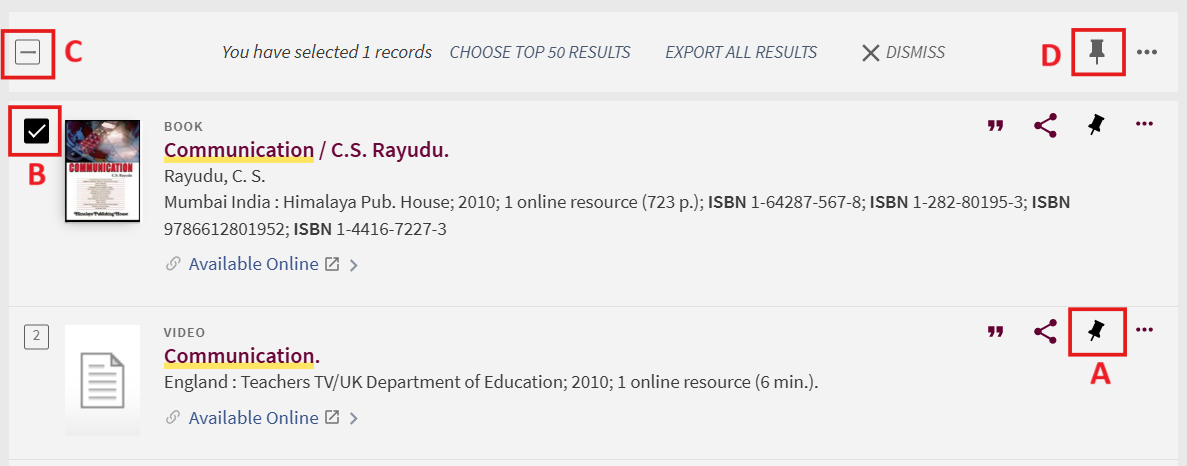
To save a single record:
- Perform a search.
- Click the “Add this item” button (A) next to the item that you want to save in the search results.
- The item added to the My Favorites will be highlighted and will have different “Remove this item” button.
To save multiple records:
- Perform a search.
- Select needed records by clicking the selection fields (B) next to the items or select all items by clicking selection field C.
- Click the “Add this item” button (D) to save in the result list.
- The item added to the My Favorites will be highlighted and will have different “Remove this item” button.
Note! The number of selections is limited to a maximum of 50 items at a time. If this limit is reached, users are prompted to edit their selections.
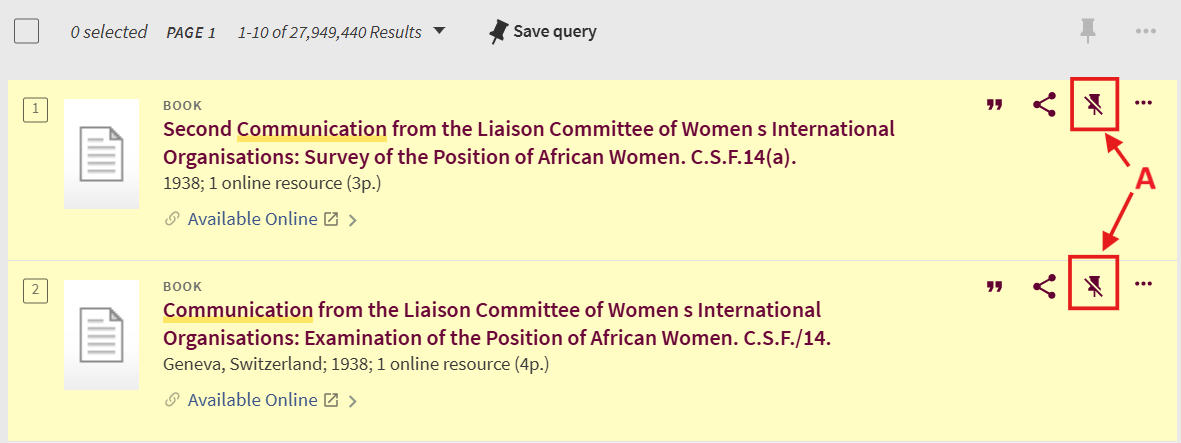
To remove an individual item from the list you can:
- Click the “Remove this item” button (A) next to the item either in the search results or on the “My Favorites > Saved Records” tab.
- For removing multiple items at the same time you can select needed items on the “My Favorites > Saved Records” tab and click “Remove selected items”.
Adding Labels to a Record
By adding labels to your records, you can then group them into the private lists. One record can have multiple labels if you want to include that record in multiple lists.
To assign labels to a record:
- Click the My Favorites button at the top of the page.
- Select the Saved Records tab.
- Click the “Add Label” button.
- Enter the name of the label in the Add new label field.
- Confirm by pressing [Enter].
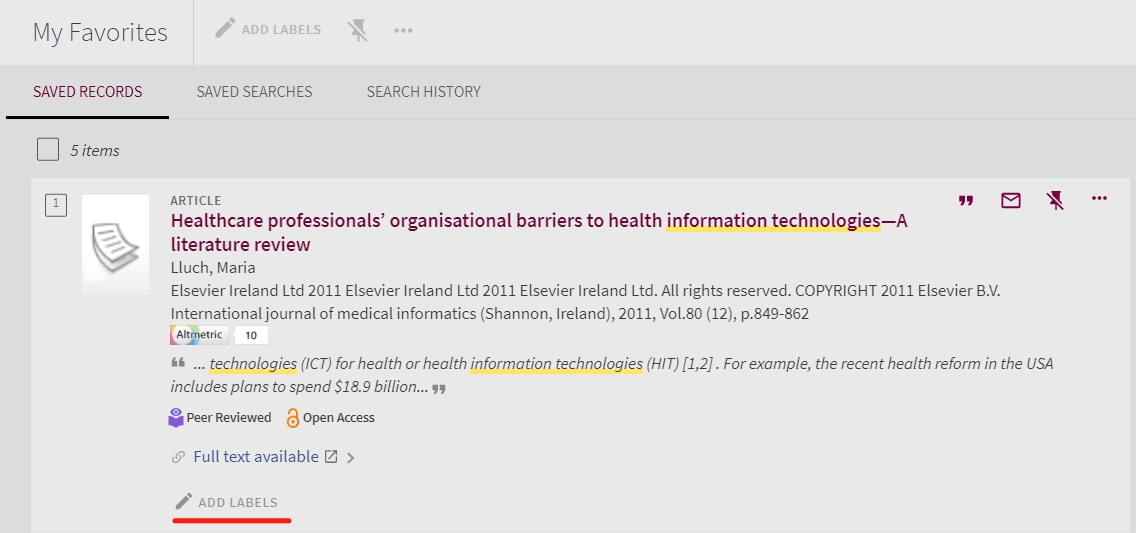

To remove a label:
- Click the My Favorites button at the top of the page.
- Select the Saved Records tab.
- Click the record’s Label Action Menu button.
- Click the Delete Label button [X] to remove the unwanted label.
To view records grouped by a label:
- Click the My Favorites button at the top of the page.
- Select the Saved Records tab.
- In the Labels section, click the label's link to view the records that have been assigned that label.
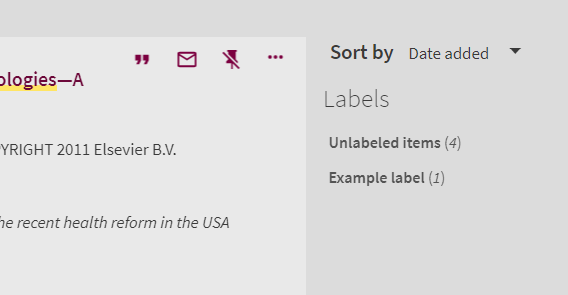
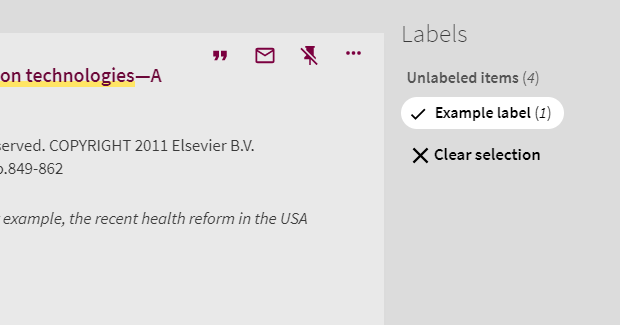
Sorting the list of Saved Records:
- Click the My Favorites button at the top of the page.
- Select the Saved Records tab.
- The Sort by options allow users to sort their list of saved records by Title, Author and Date added.
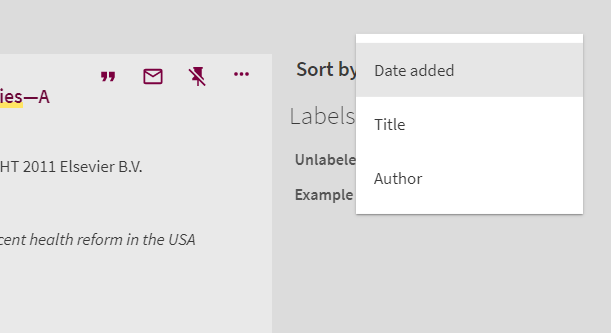
Saving Searches and Managing Saved Searches
Signed-in users are allowed to save searches between sessions and receive email alerts when there is an update to the saved search query.
Saving a Search query:
- Perform a search that you want to save.
- Click “Save Query” above the search results.
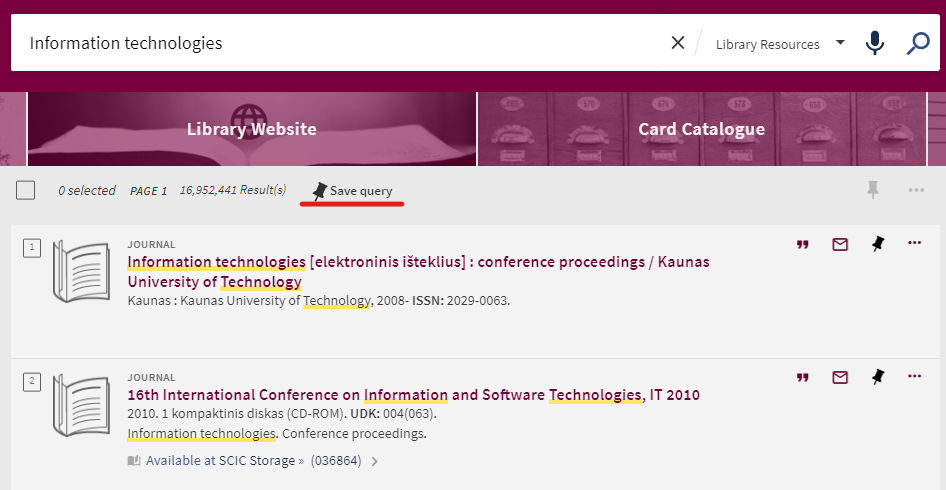
In addition, you will have an opportunity to set an alert for this query by clicking the notification link that appears after saving a query.
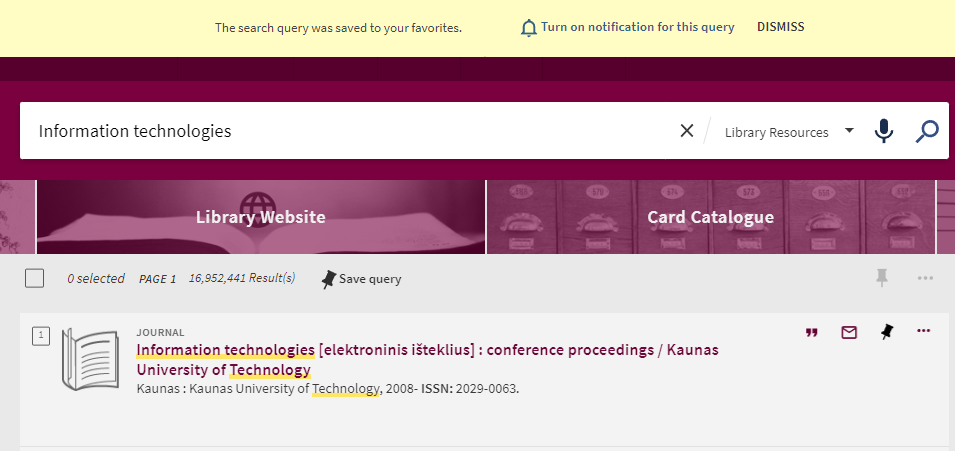
To save a query from the Search History:
- Click the My Favorites button at the top of the page.
- Select the Search History tab to display your current session's search history.
- Click the “Add this item” button that appears next to the desired query.
- Or select all desired queries (use B selectors) and click the “Add this item” button that appears in the main My Favorites menu.

To delete a saved query:
- Click the My Favorites button at the top of the page.
- Select the Saved Searches tab to display all of your saved searches.
- Click the “Remove this item” button that appears next to the saved query.

To delete a group of queries:
- Click the My Favorites button at the top of the page.
- Select the Saved Searches tab to display all of your saved searches.
- Select the check boxes (B) of the queries that you want to delete.
- Click the “Remove this item” button that appears above the list (C).
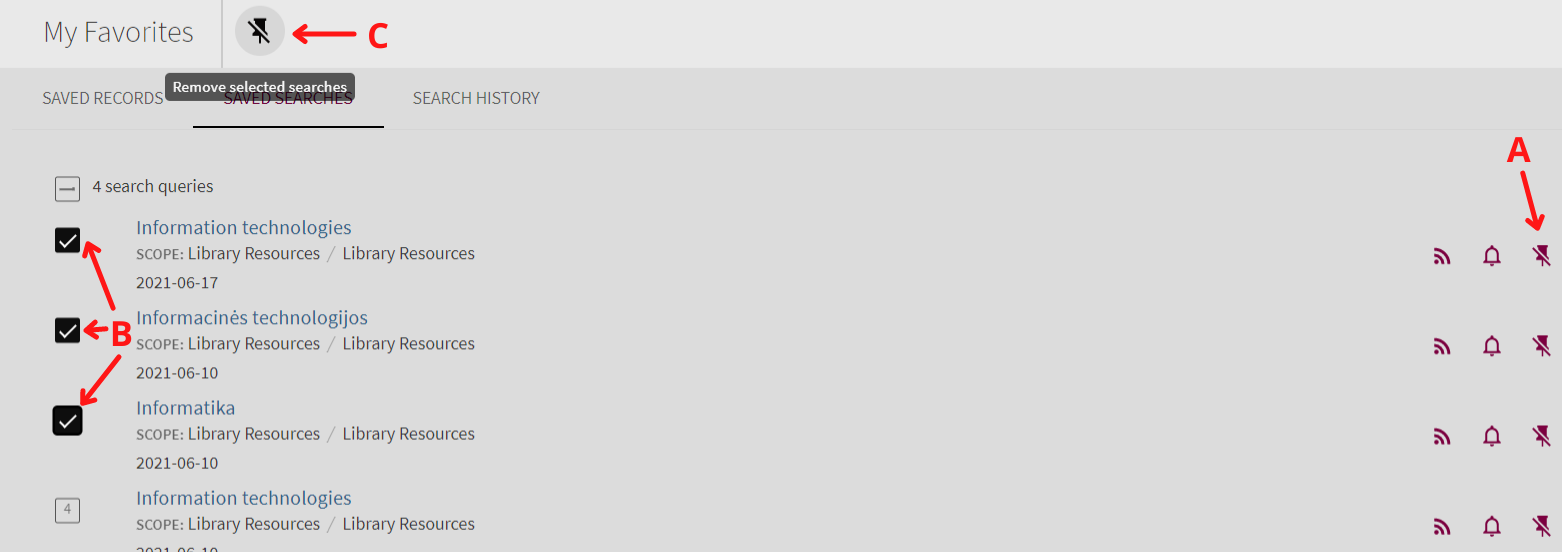
Managing Alerts
Signed-in users are allowed to receive email alerts when there is an update to the saved search query. After an alert has been set, the “My Favorites > Saved Searches” page allows users to perform the following operations on alerts: set/clear an alert and update email addresses.
To set an alert:
- Click the My Favorites button at the top of the page.
- Select the Saved Searches tab to display all of your saved searches.
- Click the “Set an alert for this search” button (A) next to the query to set the alert.
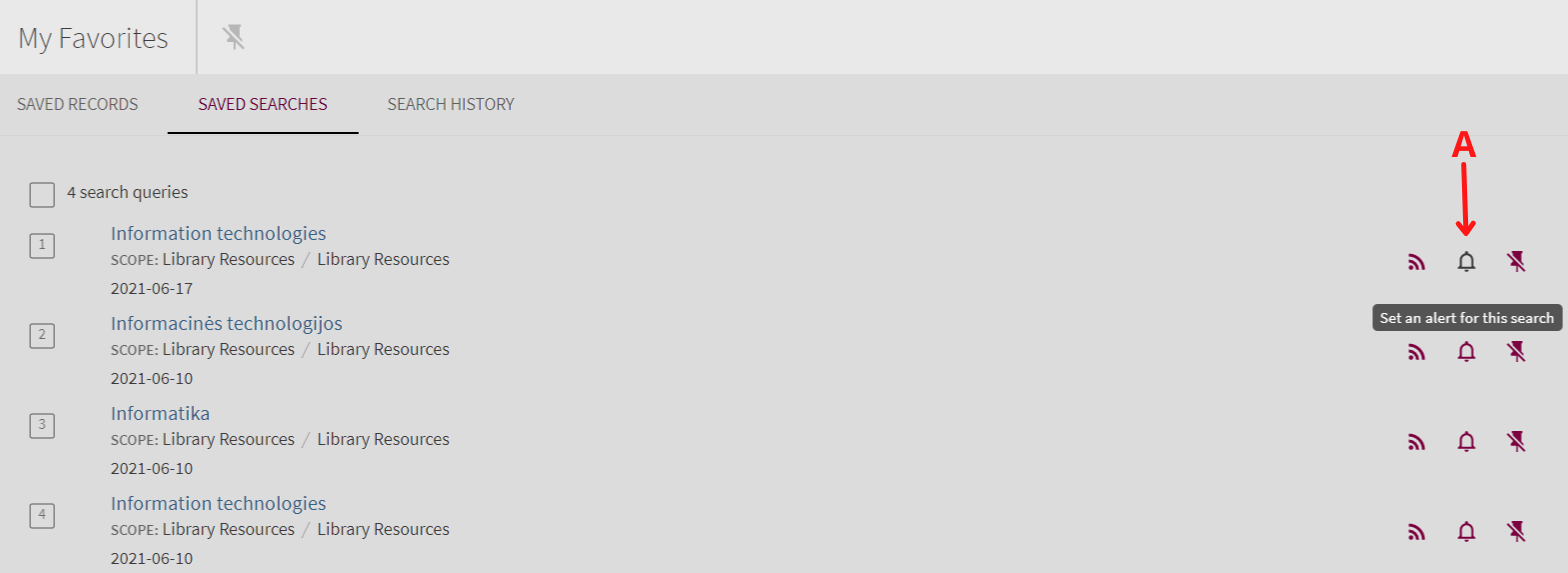
If necessary, update the email address to which the alert will be sent:
- Click the “Change email address” link in the Alert notification area.
- Type in new email and click “Save query”.

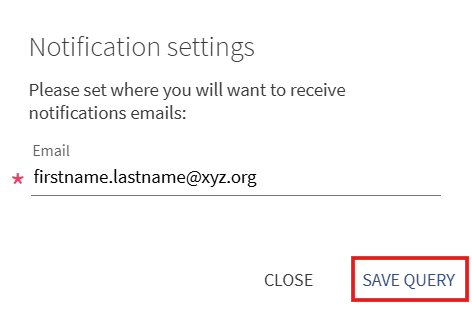
Attention! Changing the email address to a different than provided by your institution does not guarantee successful delivery of the messages.
To clear an alert:
- Click the My Favorites button at the top of the page.
- Select the Saved Searches tab to display all of your saved searches.
- Click the “Unset an alert for this search” button next to the query to clear the alert.

Activating an RSS Feed
The Rich Site Summary (RSS) functionality allows signed-in users to be informed of changes to results in their saved searches.
Enabling RSS for a saved search:
- Click the My Favorites button at the top of the page.
- Select the Saved Searches tab to display all of your saved searches.
- Click the “Set an RSS for this search” button for the saved search that you want to monitor.
Attention! Subscribe to the feed only if your browser or device has an RSS reader.

The Brief Results
The Brief Results page display all the items that match your search query. For each item, the following information displays:
- Resource Type – the format of the item, such as book, article, journal, and so forth.
- Resource title
- Brief record – the brief record of the item shows main metadata such as author, year of publication and other information. By clicking it you'll navigate to the detailed record.
- Availability status – brief information about the location and availability status of the item. By clicking, you will see detailed information about available and unavailable items and be able to request the item, if possible.
- Access terms on the internet – known access terms and other data for the item. Link to access the item on the internet.
- Item number in the result's list and the Individual Selection box – select the check box that appears next to each item in the list. As records are added to the page, the number of selected records appears above the results. You can load more results to the page to allow the selection of more records.
- Send to actions – the Send To actions allow you to perform actions on the item (such as creating a citation for the item, copying a permalink, saving the record to My Favorites and so forth).
- Save query – Click to save current search query to your favorites. Read more at Saving Searches and Managing Saved Searches.
- Applying Actions in Bulk – after you have selected one or more items, select the Actions link that appears above the list of results to display the available export actions. Selecting an export action will apply that action to all selected records.
- Refine my results – the facets on the left side of the page allow you to filter your results by categories (such resource type and creation date) and to specify a type of sort. The facets are generated from the top 10 000 records by using specialized record data. Read more at Filtering the Results.
- Resource recommender - when searching for certain keywords, the system may provide a list of recommended databases. Clicking on the name of the recommended database will take you to the website of that database. The search results list displays the first three database recommendations. You can see the full list of recommendations by clicking on "See all suggested resources".
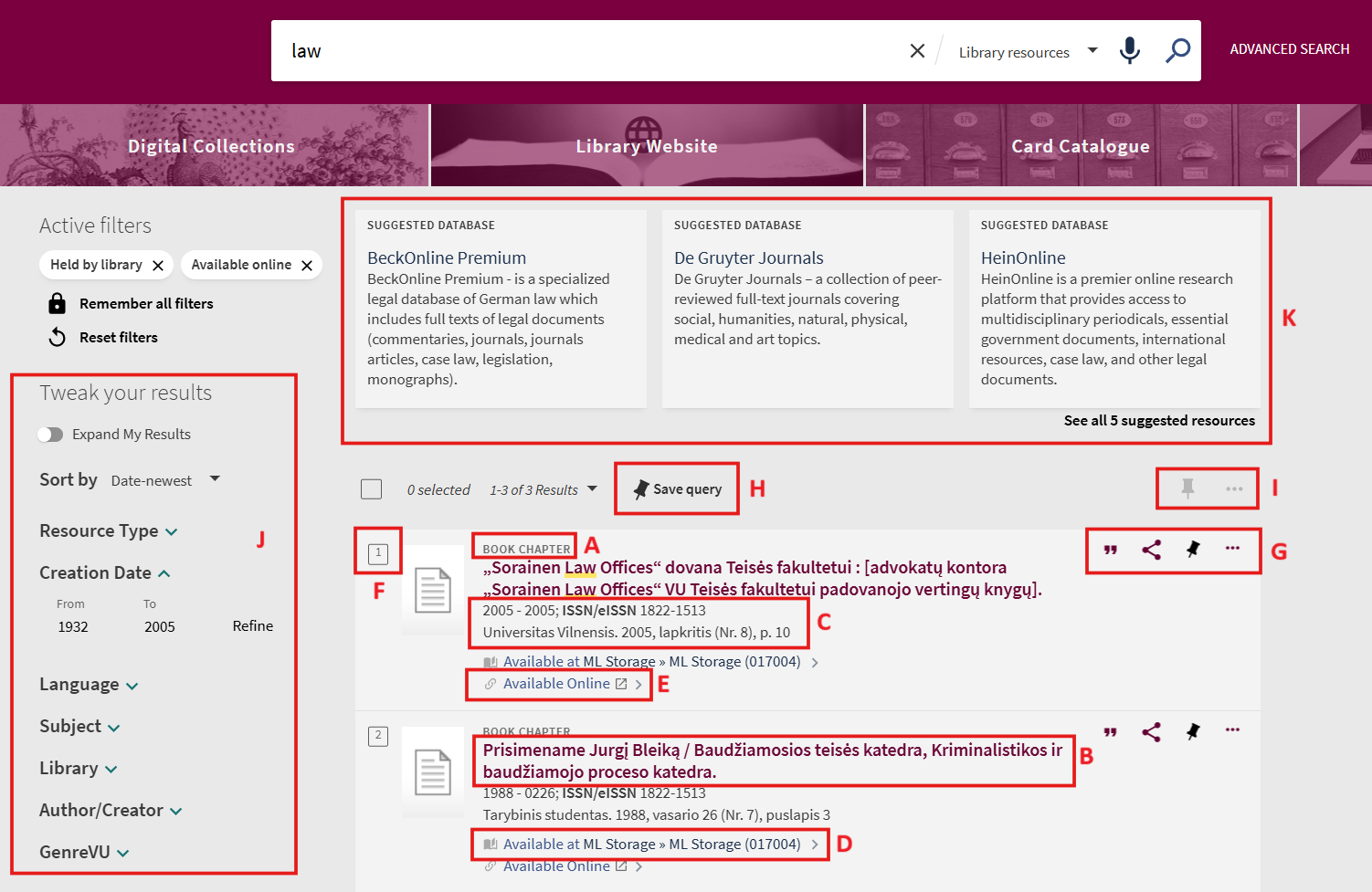
Filtering the Results
The Tweak your results section, which appear on the left side of the Brief Results page, contains a list of categories, which are referred to as facets. Each facet can be selected under both YES (including entries with selected attributes only) and NO (excluding entries with selected attributes).
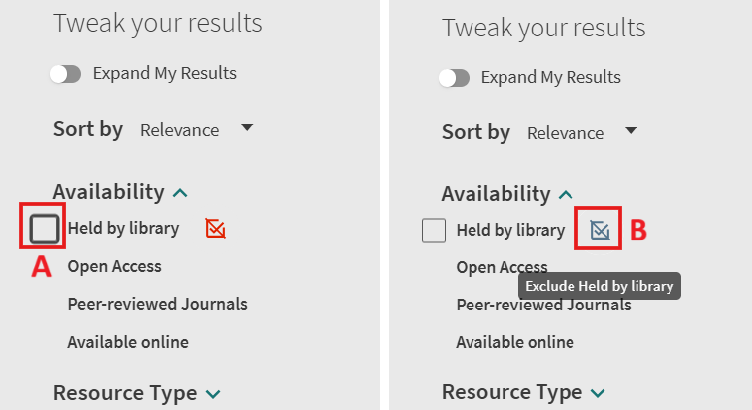
To include/exclude facets:
- Perform a search.
- For each facet that you want to include or exclude – select the check box on the left side of the facet (A) and then select include/exclude type by clicking the button on the right side of the facet (B).
- Click “Apply Filters” button to filter your results. The selected facets will appear in the Active filters section.
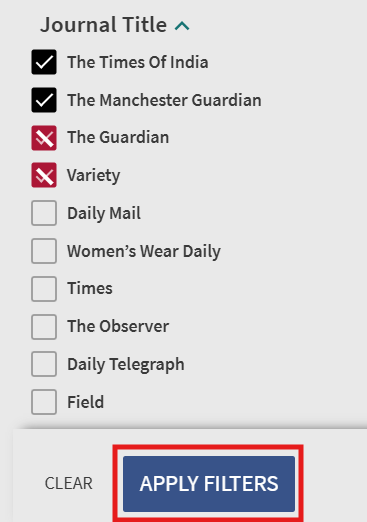
Tips for better refining your search results:
- To find out which reading room or building (CB, MKIC, ŠAIC or faculties) contains the book or other document you need, select the "Library" filter. Next to a specific reading room, you'll see in the results how many publications match your search result.
- With the “Availability” filter, you can filter only documents that are available online or available in the library.
- You can use the "Creation date" filter to set the time period for which documents are relevant to you.
- By applying the "Resource Type" filter, you will be able to filter search results by document types: books, articles, journals, dissertations, etc.
- You can use the "Sort by" feature to see more accurate and up-to-date search results at the top of the page.
Persistent Facets
When performing many similar types of searches, you may want to retain your filters for subsequent searches within a session.
To make a facet persistent, hover the cursor over the facet in the Active filters section and then click the facet's padlock button “Make this filter persistent”. To remove a filter's persistence, click the facet's padlock button “Cancel persistence” or delete the facet.
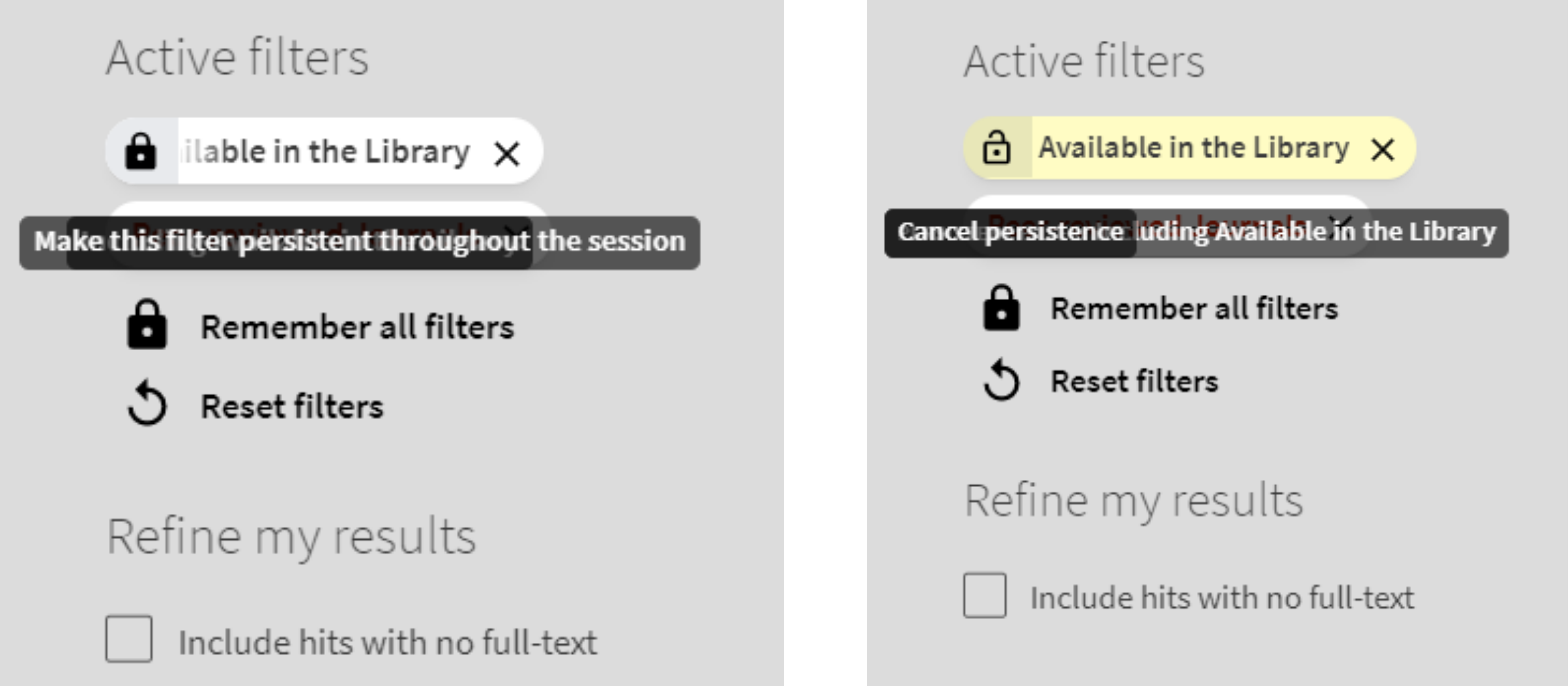
Full Display Page
After selecting an item in the Brief Results, the record's Full Display opens to display additional information. Users can either scroll to a particular section or use the links shown on the left side of the page.
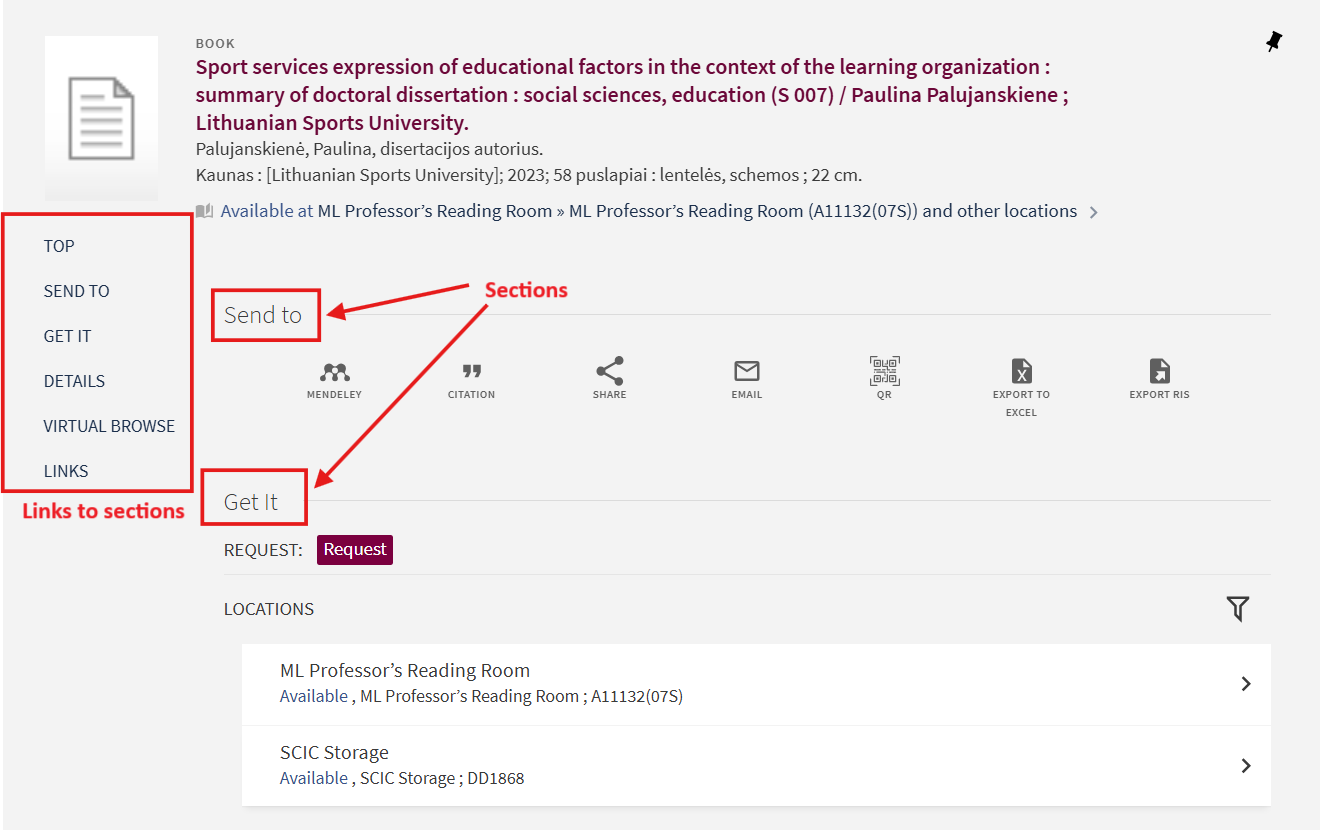
The item's information is organized by the following sections:
- Send To – This section allows users to perform the following actions on the selected item: email item details, create a citation, export to Excel, send to reference management service (such as RefWorks, Mendeley), create a permalink, etc..
- View Online – This section appears only if the item is available for online viewing and provides information on which databases the document is available in, as well as links to the full text of thedocument in the specified databases.
- Get It – This section appears only for physical resources. It provides information about the storage locations of the document, loan status and provides the opportunity to request the document, if possible.
- Details – This section displays additional details to help the user decide whether to choose this item.
- Links – This section displays additional links, which may allow you to view cover art, the Table of Contents, and so forth.
- Virtual Shelf – This section allows users to browse items based on the location of an item in the search results. The user will be able to navigate through items on the shelf, starting at the selected item’s browse/call number value.
Hold Requests
Note! Not all publications can be requested via Virtual library. See more information about publication requests here.
To place a hold request:
- Log in to your Virtual Library account.
- Perform a search for a record.
- Open the record's full display page, "Get It > Locations" section.
- Click on the "Request" button.
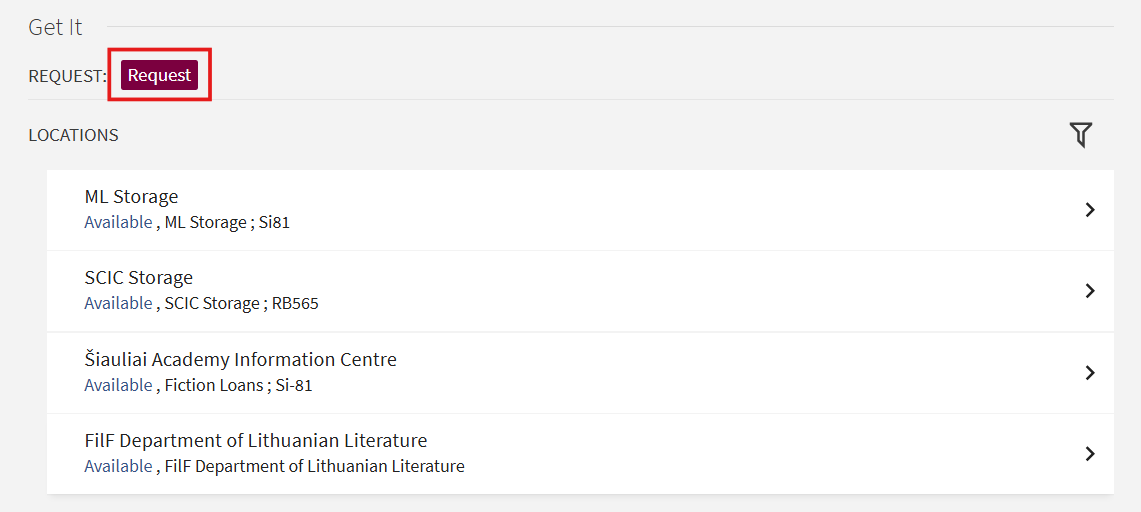 Fill out the request form: specify the pickup location (only allowed to select if there is more than one pick-up location available); select the terms of use. Short message to a librarian can be added if needed.
Fill out the request form: specify the pickup location (only allowed to select if there is more than one pick-up location available); select the terms of use. Short message to a librarian can be added if needed.- Confirm a hold request by clicking “Send Request” button.
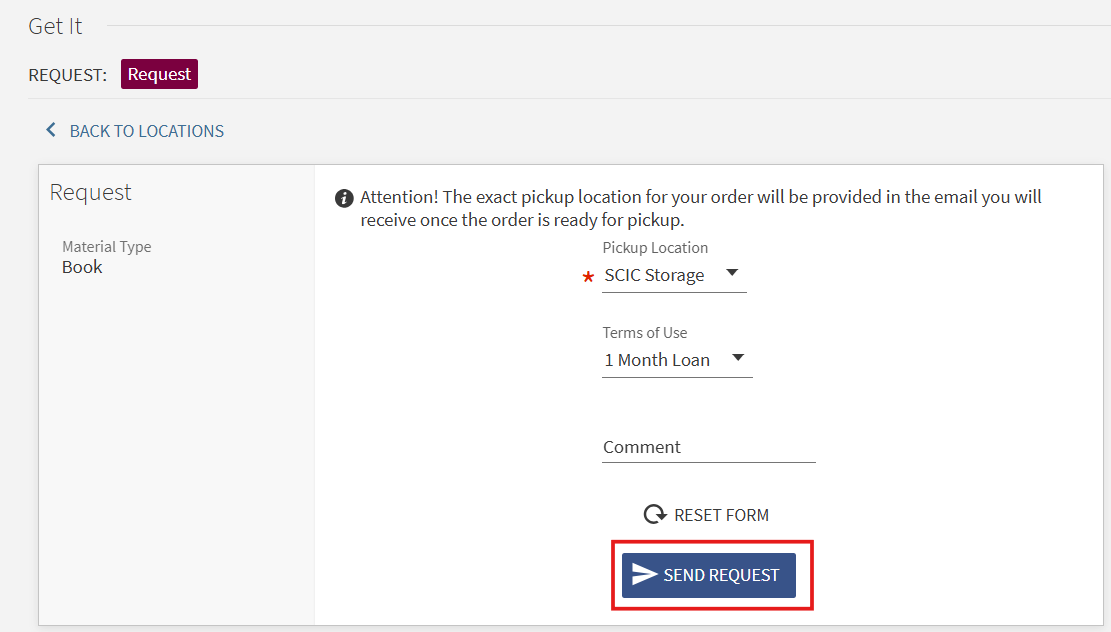
Loans, Renewing Loans
Signed-in users can see their active loans, previous and historic loans and renew active loan. Loan list can be accessed from user space My Library Card section Loans.
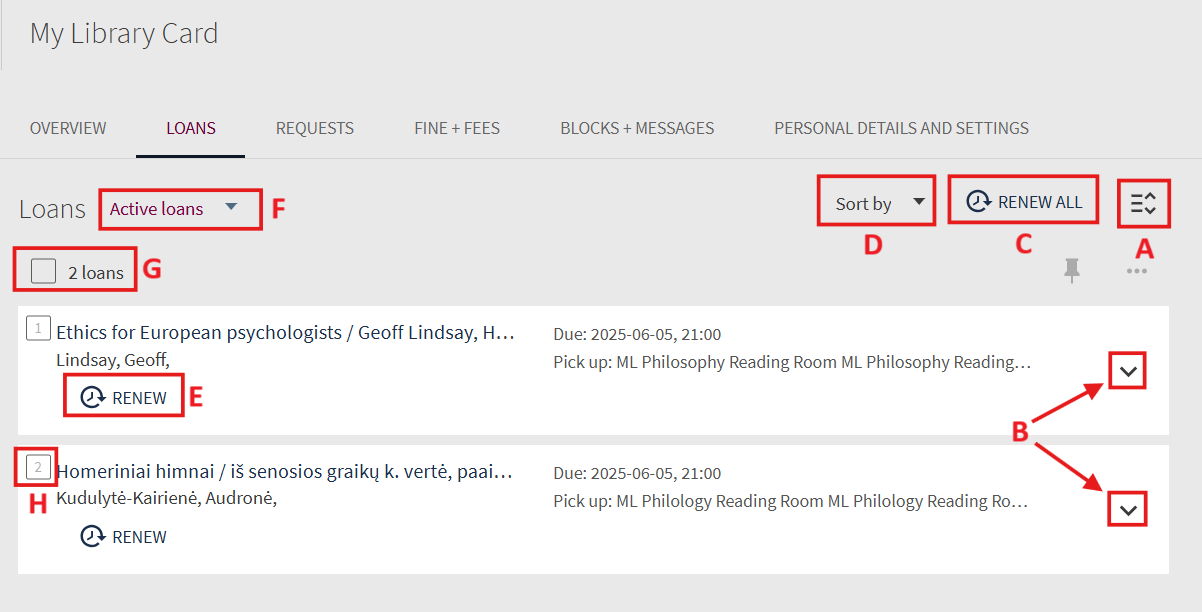
In Loans list user can:
- Click A to show detailed information for the all loans.
- Click B to show detailed information for the selected loan.
- Click C to renew all loans. The individual terms for renewal of each loan will be evaluated. If any loans were selected by function H, the button will change to Renew Selected.
- Click D to choose loans list order method.
- Click Renew (E) to renew the selected loan. Depending on the terms of renewal, the customer is allowed to renew the loan once for a maximum period of 1 month, if the loaned item has not been requested by other users.The items that cannot be renewed on the Loans tab will be marked Not Renewable icon.
- Click F to switch between Active loans and Previous and historic loans.
- Click G field to select all items in the Loans list.
- Click the number field (H) to add loan to the selection list.
Note! Loans with near due time and overdue loans are marked with additional icons and text.
Search Issues
If you encounter broken links, search issues or other problems in the virtual library, you can report them to the library staff by leaving feedback.
Click on the button in the lower right corner, select the problem area and describe the problem. If you want to leave a non-anonymous feedback or would like to receive an answer to your question, do not forget to enter your email address in the corresponding field. After filling in all the required fields, click Send.
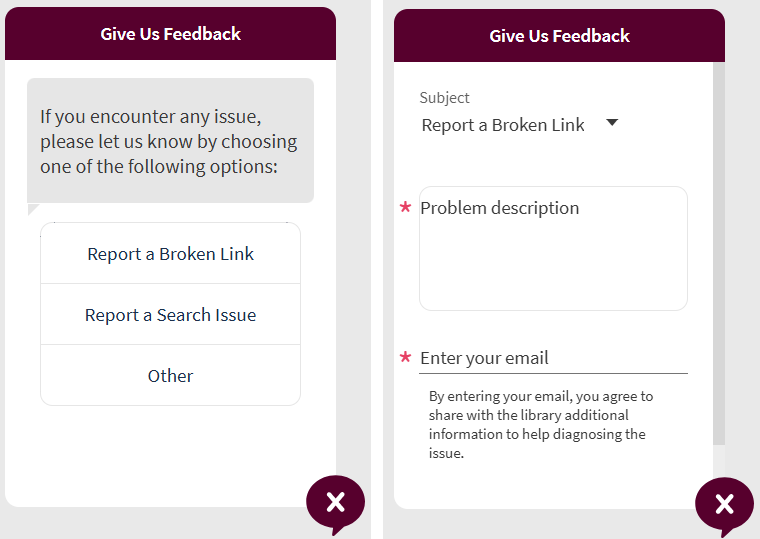
Research Assistant
The “Research Assistant” is the generative artificial intelligence (AI) tool based on the Big Language Model (GPT-4o mini).
Why try the “Research Assistant”?
- Searchable in natural language;
- Access to reliable e-resources from scientific information databases;
- Quick discovery of new research topics and suggestions for related questions to deepen your understanding of the topic.
To perform a search:
- Type your question in the search field and press Enter or the arrow button on the right (A). Questions can be asked in both English and Lithuanian.
- Important! The "Research Assistant" performs an expanded search, therefore it provides a list of both available and unavailable, but recommended information sources. To receive recommendations only for available information sources, select the "Available online" filter (C) before performing the search. You can also select relevant resource types and publication date in the filters (B).
- To clear the search field and applied filters, click on the trash can button on the right (D).

- The "Research Assistant" will find academic text summaries that most closely match the search keywords and will present five sources of scientific information. It will also generate a concise answer to the research question along with links to the sources. By clicking on the selected information source, you will be able to read its summary, and by clicking the "More details and request options" button, you will be able to view a detailed description of the source in the Virtual Library.
- On the left side, you can see your search history and clear it.
